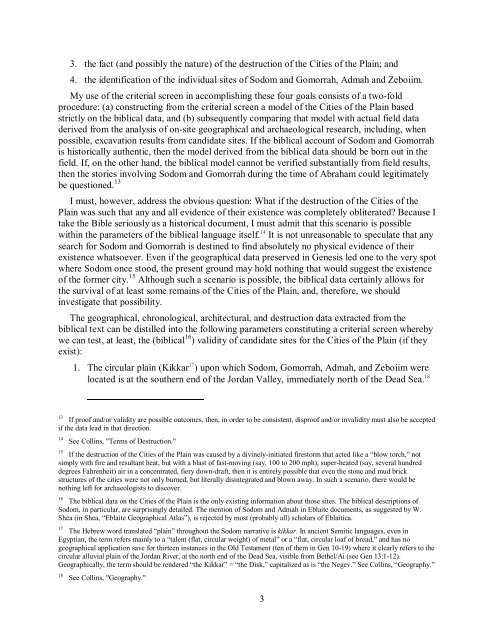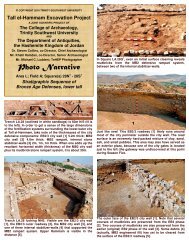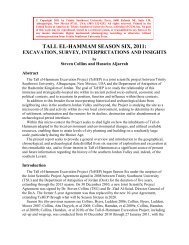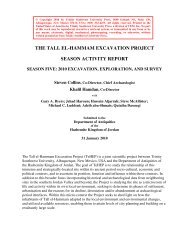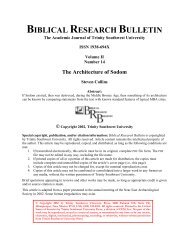Explorations on the - Tall el-Hammam Excavation Project, Jordan
Explorations on the - Tall el-Hammam Excavation Project, Jordan
Explorations on the - Tall el-Hammam Excavation Project, Jordan
You also want an ePaper? Increase the reach of your titles
YUMPU automatically turns print PDFs into web optimized ePapers that Google loves.
3. <strong>the</strong> fact (and possibly <strong>the</strong> nature) of <strong>the</strong> destructi<strong>on</strong> of <strong>the</strong> Cities of <strong>the</strong> Plain; and<br />
4. <strong>the</strong> identificati<strong>on</strong> of <strong>the</strong> individual sites of Sodom and Gomorrah, Admah and Zeboiim.<br />
My use of <strong>the</strong> criterial screen in accomplishing <strong>the</strong>se four goals c<strong>on</strong>sists of a two-fold<br />
procedure: (a) c<strong>on</strong>structing from <strong>the</strong> criterial screen a mod<strong>el</strong> of <strong>the</strong> Cities of <strong>the</strong> Plain based<br />
strictly <strong>on</strong> <strong>the</strong> biblical data, and (b) subsequently comparing that mod<strong>el</strong> with actual fi<strong>el</strong>d data<br />
derived from <strong>the</strong> analysis of <strong>on</strong>-site geographical and archaeological research, including, when<br />
possible, excavati<strong>on</strong> results from candidate sites. If <strong>the</strong> biblical account of Sodom and Gomorrah<br />
is historically au<strong>the</strong>ntic, <strong>the</strong>n <strong>the</strong> mod<strong>el</strong> derived from <strong>the</strong> biblical data should be born out in <strong>the</strong><br />
fi<strong>el</strong>d. If, <strong>on</strong> <strong>the</strong> o<strong>the</strong>r hand, <strong>the</strong> biblical mod<strong>el</strong> cannot be verified substantially from fi<strong>el</strong>d results,<br />
<strong>the</strong>n <strong>the</strong> stories involving Sodom and Gomorrah during <strong>the</strong> time of Abraham could legitimat<strong>el</strong>y<br />
be questi<strong>on</strong>ed. 13<br />
I must, however, address <strong>the</strong> obvious questi<strong>on</strong>: What if <strong>the</strong> destructi<strong>on</strong> of <strong>the</strong> Cities of <strong>the</strong><br />
Plain was such that any and all evidence of <strong>the</strong>ir existence was complet<strong>el</strong>y obliterated? Because I<br />
take <strong>the</strong> Bible seriously as a historical document, I must admit that this scenario is possible<br />
within <strong>the</strong> parameters of <strong>the</strong> biblical language its<strong>el</strong>f. 14 It is not unreas<strong>on</strong>able to speculate that any<br />
search for Sodom and Gomorrah is destined to find absolut<strong>el</strong>y no physical evidence of <strong>the</strong>ir<br />
existence whatsoever. Even if <strong>the</strong> geographical data preserved in Genesis led <strong>on</strong>e to <strong>the</strong> very spot<br />
where Sodom <strong>on</strong>ce stood, <strong>the</strong> present ground may hold nothing that would suggest <strong>the</strong> existence<br />
of <strong>the</strong> former city. 15 Although such a scenario is possible, <strong>the</strong> biblical data certainly allows for<br />
<strong>the</strong> survival of at least some remains of <strong>the</strong> Cities of <strong>the</strong> Plain, and, <strong>the</strong>refore, we should<br />
investigate that possibility.<br />
The geographical, chr<strong>on</strong>ological, architectural, and destructi<strong>on</strong> data extracted from <strong>the</strong><br />
biblical text can be distilled into <strong>the</strong> following parameters c<strong>on</strong>stituting a criterial screen whereby<br />
we can test, at least, <strong>the</strong> (biblical 16 ) validity of candidate sites for <strong>the</strong> Cities of <strong>the</strong> Plain (if <strong>the</strong>y<br />
exist):<br />
1. The circular plain (Kikkar 17 ) up<strong>on</strong> which Sodom, Gomorrah, Admah, and Zeboiim were<br />
located is at <strong>the</strong> sou<strong>the</strong>rn end of <strong>the</strong> <strong>Jordan</strong> Valley, immediat<strong>el</strong>y north of <strong>the</strong> Dead Sea. 18<br />
13 If proof and/or validity are possible outcomes, <strong>the</strong>n, in order to be c<strong>on</strong>sistent, disproof and/or invalidity must also be accepted<br />
if <strong>the</strong> data lead in that directi<strong>on</strong>.<br />
14 See Collins, "Terms of Destructi<strong>on</strong>."<br />
15 If <strong>the</strong> destructi<strong>on</strong> of <strong>the</strong> Cities of <strong>the</strong> Plain was caused by a divin<strong>el</strong>y-initiated firestorm that acted like a “blow torch,” not<br />
simply with fire and resultant heat, but with a blast of fast-moving (say, 100 to 200 mph), super-heated (say, several hundred<br />
degrees Fahrenheit) air in a c<strong>on</strong>centrated, fiery down-draft, <strong>the</strong>n it is entir<strong>el</strong>y possible that even <strong>the</strong> st<strong>on</strong>e and mud brick<br />
structures of <strong>the</strong> cities were not <strong>on</strong>ly burned, but literally disintegrated and blown away. In such a scenario, <strong>the</strong>re would be<br />
nothing left for archaeologists to discover.<br />
16 The biblical data <strong>on</strong> <strong>the</strong> Cities of <strong>the</strong> Plain is <strong>the</strong> <strong>on</strong>ly existing informati<strong>on</strong> about those sites. The biblical descripti<strong>on</strong>s of<br />
Sodom, in particular, are surprisingly detailed. The menti<strong>on</strong> of Sodom and Admah in Eblaite documents, as suggested by W.<br />
Shea (in Shea, “Eblaite Geographical Atlas”), is rejected by most (probably all) scholars of Eblaitica.<br />
17 The Hebrew word translated “plain” throughout <strong>the</strong> Sodom narrative is kikkar. In ancient Semitic languages, even in<br />
Egyptian, <strong>the</strong> term refers mainly to a “talent (flat, circular weight) of metal” or a “flat, circular loaf of bread,” and has no<br />
geographical applicati<strong>on</strong> save for thirteen instances in <strong>the</strong> Old Testament (ten of <strong>the</strong>m in Gen 10-19) where it clearly refers to <strong>the</strong><br />
circular alluvial plain of <strong>the</strong> <strong>Jordan</strong> River, at <strong>the</strong> north end of <strong>the</strong> Dead Sea, visible from Be<strong>the</strong>l/Ai (see Gen 13:1-12).<br />
Geographically, <strong>the</strong> term should be rendered “<strong>the</strong> Kikkar” = “<strong>the</strong> Disk,” capitalized as is “<strong>the</strong> Negev.” See Collins, “Geography.”<br />
18 See Collins, "Geography."<br />
3


